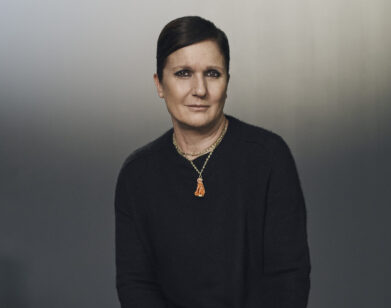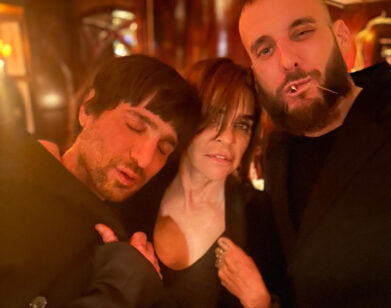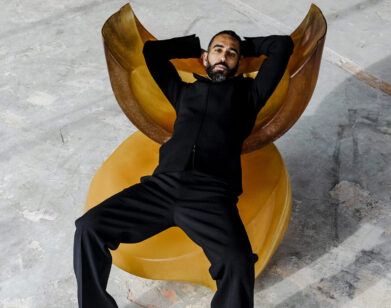Laura Dawson Enters the Geodesic Dome

Photographs by Kashish Shrestha
After a post-college trip to Europe, Laura Dawson arrived in New York City in 2002, just in time for a brutal East Coast winter. She had come across a yarn store of interest while staying in Amsterdam, and subsequent experiments with jumbo knitting needles and fat wool yarn yielded a series of hats—an outsized take on the classic beanie whose sales paid the rent by season’s end. The modest project soon segued into her first full collection, in 2003. A gig with threeASFOUR—or AsFour, as the collective was then known—and a stint at Donna Karan, and forays into the music industry followed suit (costumes for Scissor Sisters and Brazilian Girls; T-shirts for Moby). I met up with Dawson in her Lower East Side studio just days before her Fall 2009 collection debuted at the Redbull Space in SoHo. Dawson’s runway show for Fall 2009, “Glitch Geometric Design,” was realized in collaboration with the Buckminster Fuller Institute, whose geodesic structure-cum-set complemented a hard-edged collection of 18 black and grey grey looks. I tried on the clothes as Dawson and her assistants moved into the final stages of production.
SH: I’m going to interview you while I try on the clothes. [WIGGLING INTO SEQUINED COCKTAIL DRESS DESIGNED FOR PERFORMA’S 2009 BENEFIT GALA, THE METAL BALL.] Interesting architecture on this … Can I try on everything?
LD: Yes! [LAUGHS]
SH: I remember the first time I met you. I told you the straps of a dress you had done reminded me of a sculpture by Eva Hesse. You design with many references to art and architecture, but you don’t look to either right? What do you look at?
LD: Most recently I’ve been looking at Buckminster Fuller. I used to have several heroes that were living-then I met them all, and they were hugely disappointing. So Bucky Fuller is fool proof. His philosophy works perfectly for me. All of his ideas about efficiency: That you can make everything with nothing; that you don’t need anything to make everything. You don’t need backing, you don’t need tons of materials, you don’t need waste; you don’t need war, government, conflict, housing code—you just don’t need it.
Laura Dawson; a look from Fall 2009. Photo by Pierre le Hors.
SH: Just do it.
LD: Right. I love the idea of clothes-as-systems: “I don’t need new leather, I can just used recycled soda bottles.” You know how if you’re careful while peeling a tangerine, you can get it to all come off in one piece? I’m just fascinated by that—that you can take one flat thing, and turn it into a globe. I wanted to reverse engineer an orange, and make a dress of it.
SH: How do you do that?
LD: My mom is an engineer. She helped develop holograms as an undergrad; her thesis helped change refrigerator manufacturing, and she designed a non-addictive cigarette (that Phillip Morris rejected). When I was a child and my mom bathed me, she would ask: “Why does the drain stop when you pull the plug?” I would figure it out, and we’d move on to the next question. I’m more of a scientist’s fashion designer, rather than an artist’s or architect’s.
SH: It’s about problem solving. Here’s the challenge: “I am MacGyver. How am I going to deconstruct this alarm clock and make it into … “
LD: An airplane!
SH: A fish bowl! Even in trying on that dress—the one you designed based on the concept of unpeeling an orange—I can see in the pleats, and in the seams, and in the curves. Especially in that one—I feel that you solved problems through the form, like “here’s the body and I need to clothe it. Now what do I do?”
LD: Exactly. I feel like some design tries to enhance the shape of the body, and some design tries to—not to ignore it, but to reshape it into something that’s totally alien, and other, and else. I feel like you’ve made a success if you’ve made something that nobody’s ever seen before or felt before— if it genuinely feels new.
SH: You worked with ThreeASFOUR.
LD: It was an excellent time. When I interviewed to intern for them—it was unpaid work; I was right out of school–I walked in with this cashmere coat that I had done during my thesis and they had the coat on their mannequin and they were building it. They had never seen it, and they were the same, line for line. It was shocking.
SH: So it was like “you’re hired,” on the spot.
LD: Kind of. I walked in, and the room fell silent. It was awesome.
SH: You were 23, in your little cashmere coat.
LD: If I had my way, I would work there forever and not do anything else. They’re not always set up for that, given the nature of what they do and how they work. It was unpaid, so I had to move on. They’ve always been supportive.
SH: How has it been working with some showbusiness folks?
LD: Scissor Sisters have a song called “Laura” where they sing “Won’t you just tell Cincinatti” and it’s about a girl who cuts hair. A friend called me up and said, “Someone wrote a song about you.”
SH: They wrote about you?
LD: I used to cut my own hair and other peoples’ hair—it was a bit scene-y. I went to a Scissor Sisters show in San Francisco—they were still sound checking and I just went up to them and said: I’m Laura from Cincinnati. And they said, “Who the fuck are you?”
SH: So was the song about you?
LD: No, but once they met me … I was on their tour bus, and [Scissor Sisters’ songwriter] Babydaddy just looked at me. I said, “You’re wondering who I am and what I’m doing on your tour bus.” He was like, “Uh huh.” Jake [Shears] was there and he said, “I really like your look. You make clothes, don’t you?” I said yes, and he said he wanted some.
SH: So what did you end up doing for him?
LD: I designed a whole collection for him, thinking I needed to give him something to throw out because clients usually don’t like everything. He ordered almost all of it. We made pony skin pants … it was bright, shiny stuff and daredevil silhouettes. I kept a classic color palette though, until I saw what Heatherette was doing for him—they were doing crazy stuff; leotards, Formula One-style suits. I decided to pull out all the stops then, color-wise. I used a florescent pink fabric printed with kissing lips, purple cheetah-print fabric, and a blue-ish fake snakeskin—all in one garment. [PULLS OUT A GOLD VEST]
SH: How did you end up working with Moby?
LD: Moby is completely anti-fashion—it’s nearly impossible to get him to change clothes or bathe when he’s on tour. Okay, he probably bathes, but I know for a fact that no laundry is done on tour. I designed a line of T-shirts with these really beautiful monochrome black prints on them. On some of the shirts I did black on dark grey; in others, matte gold on dark grey. I wasn’t sure that he was going to like them.
SH: How did you know him?
LD: I worked at Teany, his restaurant. That’s how I paid the rent while working at AsFour. It was a peculiar situation where I was serving all of these people who went to Berkeley and Harvard and had never worked a day in their life. Every one knew me as a waitress, and I had a double life. One day, a customer and a friend of a friend, actually said to me “You’re not a fashion designer, you’re a waitress.” I had just been filmed by French Vogue working on a garment for AsFour whose design was based on that hat … We engineered these huge needles so that I could make a knit that was as thick as a fur. It looked like an art performance when I was making it. And then three days later, someone says: “You’re a waitress.” I said, “OK, I’m putting Anthrax in your mail, and then I’m quitting this job.”
SH: And then you proved them wrong.
LD: Yes.






